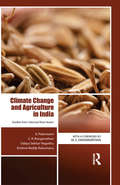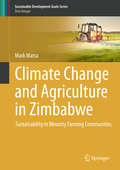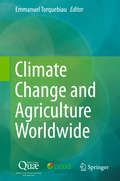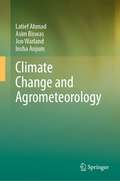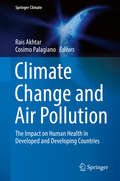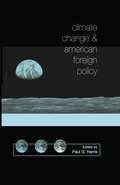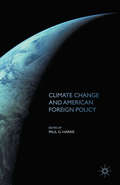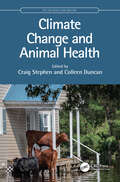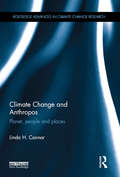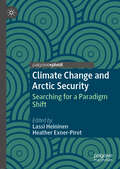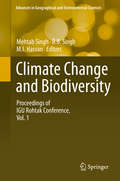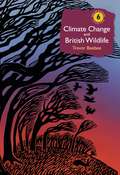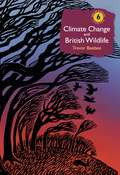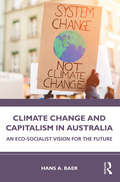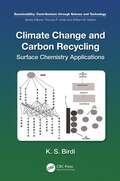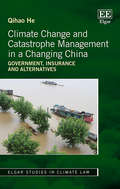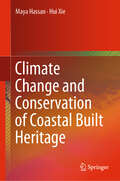- Table View
- List View
Climate Change and Adaptation for Food Sustainability: Implications and Scenarios from Malaysia
by Ferdous Ahmed Abul Quasem Al-Amin Zeeda Fatimah MohamadThis book assesses the vulnerability impacts of climate change on food security by examining a 50 years scenario (2015- 2065) and following a top-down approach. Importantly, looking at the sustainable food production, the authors compared the cost-benefit of adaptation costs from 2015 to 2065. It was found that a 15% adaptation capacity is more efficient for Malaysia in order to combat the climate change effects on the food sector. This book has developed a quantitative adaptive model namely, the Malaysian Climate and Economy (MCE) model, based on the dynamic Computable General Equilibrium (CGE) modeling structure to examine food sustainability and adaptation strategies. Malaysia experiences an unusual combination of droughts and extreme rainfall events that can be attributed to climate change. These unusual events and consequences leave Malaysian policymakers looking for ways to make Malaysia self-sufficient in terms of agriculture. It is assumed that climate change effects may result in increasing food insecurity and vulnerability in the future. Policy measures are in place to lessen the likely climatic effects overall, but there is an urgent need to develop an adaptation policy for the future.
Climate Change and Agriculture in India: Studies from Selected River Basins
by K. Palanisami C. R. Ranganathan Udaya Sekhar Nagothu Krishna Reddy KakumanuThis book provides an overview of climate change in India using river basin data and analytical and econometric methods. It, first, makes a quantitative assessment of how climate change affects agricultural and food production systems; second, predicts how these systems may respond to climate change; and third, suggests adaptation measures and strategies to improve the income of farmers, increase production, save water and conserve environment.The work will be greatly useful to policy-makers, researchers and teachers of agricultural economics, environmental studies and economics and development studies as also to research organizations dealing with climate modelling and resource management.
Climate Change and Agriculture in India: Studies from Selected River Basins
by K. Palanisami C. R. Ranganathan Udaya Sekhar Nagothu Krishna Reddy KakumanuThis book provides an overview of climate change in India using river basin data and analytical and econometric methods. It, first, makes a quantitative assessment of how climate change affects agricultural and food production systems; second, predicts how these systems may respond to climate change; and third, suggests adaptation measures and strategies to improve the income of farmers, increase production, save water and conserve environment.The work will be greatly useful to policy-makers, researchers and teachers of agricultural economics, environmental studies and economics and development studies as also to research organizations dealing with climate modelling and resource management.
Climate Change and Agriculture in Zimbabwe: Sustainability in Minority Farming Communities (Sustainable Development Goals Series)
by Mark MatsaThis book proves, through empirical research, that indigenous and traditional agricultural communities have experienced severe climate change impacts, and have developed corresponding livelihood strategies to strengthen their resilience in a variable climate. With a focus on indigenous minority farming communities in the developing region of South-Western Zimbabwe, the study presents both qualitative and quantitative approaches of data analysis to assess sustainability problems amid climate change and climate variability challenges, and proposes potential solutions. In eight chapters, the book expands on the scarce availability of community-based research on climate change and variability in Zimbabwe.The book is meant for college and university students and stakeholders involved in development work in rural minority farmer communities, especially in climate change prone regions of Africa and other developing countries who have very few options of adaptation and mitigation.
Climate Change and Agriculture Worldwide
by Emmanuel TorquebiauIn recent years, especially with the approach of the 21st Session of the Conference of the Parties to the United Nations Framework Convention on Climate Change in Paris in late 2015, the number of publications, conferences and meetings on climate change has been growing exponentially. Yet uncertainties remain concerning rural tropical areas where models are forecasting the onset of multiple disorders and trends are unclear. Meanwhile, the impact of climate change on the poorest communities is regularly documented, often prompting alarmist reactions. How can food security be achieved while adapting to and mitigating climate change? What are the main threats to agriculture in developing countries? How do farmers in these countries cope with the threats? What does agricultural research propose? What options have yet to be investigated? A broad scope of scientific research is underway to address these challenges. Diverse solutions are available, including new agricultural practices, water management, agricultural waste recycling, diagnosis of emerging diseases, payment for ecosystem services, etc. Gaining insight into the financial and political mechanisms that underlie international climate negotiations is also essential to design practical ways to deal with climate issues and meet sustainable development requirements in collaboration with farmers. This book pools the wealth of experience of dozens of researchers and development officers from a range of disciplines. We have focused on making it detailed, accurate and hopefully easy to read for researchers, students and all other informed readers.
Climate Change and Agrometeorology
by Latief Ahmad Asim Biswas Jon Warland Insha AnjumThe monograph focuses on agricultural meteorology and climate change and its impacts on different crops. Comprising of chapters from experts, the book discusses and provides first-hand information to the long term shifts in weather patterns and temperature impacting soil, water and crops. Each chapter focuses in detail on the impact of plant- water – soil nexus and climate change on agriculture and food security. Covering the basic concepts about the temperature, pressure and humidity correlation with the increased demands of food, the book explores in detail the impact of adverse climatic conditions like drought, floods, increasing levels of carbon dioxide emissions and other simultaneous effects like soil fertility depletion on the cropping systems and overall crop productivity. The book touches the challenges of climate change, adaptive methods, mitigation strategies, with careful explanation of governance, plans and policies required to provide guidelines to stake holders so they can best prepare for the negative climate change impacts. While touching the agricultural challenges faced globally due to climate change, the book serves as a reference book for students, researchers and policy makers, involved in horticulture, agriculture and environmental sciences and climate change.
Climate Change and Air Pollution: The Impact on Human Health in Developed and Developing Countries (Springer Climate)
by Rais Akhtar Cosimo PalagianoThis book discusses regional and international climate-change, air- pollution and human-health scenarios. The research, from both industrialized and developing countries, focuses on region-specific perspectives of climate change impacts on air pollution. After analyzing the variations of climate data over recent decades, the authors consider the different effects of climate change on air pollution and health. As stressed by the IPCC, “pollen, smoke and ozone levels are likely to increase in a warming world, affecting the health of residents of major cities. Rising temperatures will worsen air quality through a combination of more ozone in cities, bigger wild fires and worse pollen outbreaks,” according to a major UN climate report. The report follows the World Health Organization in finding that air pollution is the world’s greatest environmental health risk, killing 7 million people in 2014 (compared to 0.4 million deaths due to malaria). Deteriorating air quality will most affect the elderly, children, people with chronic ill-health and expectant mothers. Another report suggests that more than 5.5 million people die prematurely each year due to air pollution with over half of those deaths occurring in China and India. A study on the air pollution in the USA,suggests that more than half of US population lives in areas with potentially dangerous air pollution, and about six out of 10 of the top cities for air pollution in the USA are located in the state of California.In the face of future climate change, scientists have urged stronger emission controls to avoid worsening air pollution and the associated exacerbation of health problems, especially in more populated regions of the world. It is hoped that the implementation of the Paris Climate Agreement will help minimize air pollution.Additionally the authors consider the various measures that different countries and groups of countries, like the European Union, have adopted to mitigate the problems arising from climate change and to safeguard the health of population. The book examines the increasing incidence of diseases largely caused by climate change. The countries/regions covered in this study include the USA, Northern Europe (U.K).,Southern Europe ( Italy), Canada, Australia, East Asia, Russia, Hong Kong, Taiwan, Thailand, Malaysia, Indonesia, India, South Africa, Mexico, Brazil, Caribbean countries, and Argentina.
Climate Change and American Foreign Policy
by Paul G. HarrisClimate change is the biggest challenge facing the world. The role played by the United States may determine our collective future. Newly availab.e in paperback, Climate change and American Foreign Policy examines the actors, institutions, and ideas shaping US policies and actions. Updated with a comprehensive preface by the editor, the book introduces the issue of climate change in the context of US foreign policy. It analyses policies and critically evaluates the US role. Chapters cover a full range of topics, including climate science, economics and regulation, domestic politics and nongovernmental organizations, the presidency and Congress, diplomacy and negotiations leading to international agreements on climate change, environmental regimes, and questions of responsibility and justice. The book concludes by looking at how international norms have influenced US climate change policies. Climate Change and American Foreign Policy will be of interest to everyone concerned about climate change, global environmental politics, US foreign policy, and international relations.
Climate Change and American Foreign Policy
by Paul G. HarrisNow available in an updated 2016 edition, Climate Change and American Foreign Policy examines the actors, institutions, and ideas shaping U.S. policy on climate change (global warming). The book begins by introducing the issue of climate change in the context of U.S. foreign policy, before critically evaluating U.S. policies and actions. It then analyses the domestic and international politics of U.S. climate change policy, covering such issues as science, the presidency and Congress, nongovermental organizations, diplomacy and the international negotiations leading to the Framework Convention on Climate Change and the Kyoto Protocol. The book concludes by looking at the role of international norms in shaping U.S. climate change policy.
Climate Change and Animal Health (CRC One Health One Welfare)
by Craig Stephen Colleen DuncanThis benchmark publication assembles information on the current and anticipated effects of climate change on animal health. It empowers educators, managers, practitioners, and researchers by providing evidence, experience, and opinions on what we need to do to prepare for, and cope with, the largest threat ever to have faced animals on this planet. With expert contributors from across the globe, the text equips the reader with information and means to develop sustainable adaptation or mitigation actions. After introducing animal health in a climate change context, chapters look at specific animal health impacts arising from climate change. The book concludes with suggestions on teachable and actionable ideas that could be used to mobilize concepts provided into education or advocacy. This book was written amid the COVID-19 pandemic and in the face of ever-increasing reports of on-the-ground, real-life climate impacts. Large scale wildfire and ocean heat waves killed unprecedented numbers of animals while droughts in some areas and floods in others displaced thousands of livestock and made food scarce for even more. Climate change is real, and it is here. How we respond will have profound implications for people, biodiversity, welfare, conservation, societies, economies and ecosystems. Today's veterinary educators are awakening to the need to adapt and train a new generation of animal health professions who can understand and plan for climate change, and this book is an essential resource.
Climate Change and Animal Health (CRC One Health One Welfare)
by Craig Stephen Colleen DuncanThis benchmark publication assembles information on the current and anticipated effects of climate change on animal health. It empowers educators, managers, practitioners, and researchers by providing evidence, experience, and opinions on what we need to do to prepare for, and cope with, the largest threat ever to have faced animals on this planet. With expert contributors from across the globe, the text equips the reader with information and means to develop sustainable adaptation or mitigation actions. After introducing animal health in a climate change context, chapters look at specific animal health impacts arising from climate change. The book concludes with suggestions on teachable and actionable ideas that could be used to mobilize concepts provided into education or advocacy. This book was written amid the COVID-19 pandemic and in the face of ever-increasing reports of on-the-ground, real-life climate impacts. Large scale wildfire and ocean heat waves killed unprecedented numbers of animals while droughts in some areas and floods in others displaced thousands of livestock and made food scarce for even more. Climate change is real, and it is here. How we respond will have profound implications for people, biodiversity, welfare, conservation, societies, economies and ecosystems. Today's veterinary educators are awakening to the need to adapt and train a new generation of animal health professions who can understand and plan for climate change, and this book is an essential resource.
Climate Change and Anthropos: Planet, people and places (Routledge Advances in Climate Change Research)
by Linda H. ConnorAnthropos, in the sense of species as well as cultures and ethics, locates humans as part of much larger orders of existence – fundamental when thinking about climate change. This book offers a new way of exploring the significance of locality and lives in the epoch of the Anthropocene, a time when humans confront the limits of our control over nature. Many scholars now write about the ethics, policies and politics of climate change, focussing on global processes and effects. The book’s innovative approach to cross-cultural comparison and a regionally based study explores people’s experiences of environmental change and the meaning of climate change for diverse human worlds in a changing biosphere. The main study site is the Hunter Valley in southeast Australia: an ecological region defined by the Hunter River catchment; a dwelling place for many generations of people; and a key location for transnational corporations focussed on the mining, burning and export of black coal. Abundant fossil fuel reserves tie Hunter people and places to the Asia Pacific – the engine room of global economic growth in the twenty-first century and the largest user of the planet’s natural resources. The book analyses the nexus of place and perceptions, political economy and social organisation in situations where environmental changes are radically transforming collective worlds. Based on an anthropological approach informed by other ways of thinking about environment-people relationships, this book analyses the social and cultural dimensions of climate change holistically. Each chapter links the large scales of species and planet with small places, commodity chains, local actions, myths and values, as well as the mingled strands of dystopian imaginings and strivings for recuperative renewal in an era of transition.
Climate Change and Anthropos: Planet, people and places (Routledge Advances in Climate Change Research)
by Linda H. ConnorAnthropos, in the sense of species as well as cultures and ethics, locates humans as part of much larger orders of existence – fundamental when thinking about climate change. This book offers a new way of exploring the significance of locality and lives in the epoch of the Anthropocene, a time when humans confront the limits of our control over nature. Many scholars now write about the ethics, policies and politics of climate change, focussing on global processes and effects. The book’s innovative approach to cross-cultural comparison and a regionally based study explores people’s experiences of environmental change and the meaning of climate change for diverse human worlds in a changing biosphere. The main study site is the Hunter Valley in southeast Australia: an ecological region defined by the Hunter River catchment; a dwelling place for many generations of people; and a key location for transnational corporations focussed on the mining, burning and export of black coal. Abundant fossil fuel reserves tie Hunter people and places to the Asia Pacific – the engine room of global economic growth in the twenty-first century and the largest user of the planet’s natural resources. The book analyses the nexus of place and perceptions, political economy and social organisation in situations where environmental changes are radically transforming collective worlds. Based on an anthropological approach informed by other ways of thinking about environment-people relationships, this book analyses the social and cultural dimensions of climate change holistically. Each chapter links the large scales of species and planet with small places, commodity chains, local actions, myths and values, as well as the mingled strands of dystopian imaginings and strivings for recuperative renewal in an era of transition.
Climate Change and Arctic Security: Searching for a Paradigm Shift
by Lassi Heininen Heather Exner-PirotThis book assesses the construction of security in the context of climate change, with a focus on the Arctic region. It examines and discusses changes in the security premises of the Arctic states, from traditional security to environmental and human security. In particular, the book explores how climate change impacts security discourses and premises as well as theoretically discussing the possibility for another change, from circumpolar stability into peaceful change. Chapters cover topics such as the ethics of climate change in the arctic, China’s emerging power and influence on arctic climate security, the discursive transformation of the definition of security and the intersection between urban, climate and Arctic studies. The book concludes with the question of whether a paradigm shift in our understanding of traditional security is possible, and whether it is already occurring in the Arctic.
Climate Change and Atmospheric Deposition as Drivers of Forest Ecosystem Integrity and Services: A Methodology for Assessing and Mapping Ecosystem Services across Time and Space (SpringerBriefs in Environmental Science)
by Winfried Schröder Angela SchlutowThis book is intended to provide a hitherto missing English-language overview of a multi-year research project in which a comprehensive methodology was developed to assess a rule-based classification of the habitat services, the primary net biomass productivity and carbon sequestration capacity. The comprehensive methodology presented operationalises the specifications of the MAES working group quantitatively. The MAES classification framework for integrative ecosystem assessments comprises the mapping of ecosystems, the classification of ecosystem conditions (ecosystem condition information for individual indicators, ecosystem functions and ecosystem types), the classification of ecosystem services and their integration. The presented rule-based classification of the three ecosystem services examined in depth using quantitative indicators is unique in the EU to date.
Climate Change and Biodiversity: Proceedings of IGU Rohtak Conference, Vol. 1 (Advances in Geographical and Environmental Sciences)
by Mehtab Singh R. B. Singh M. I. HassanThe over-exploitation of important earth resources such as land and water has led to a number of environment-related problems the world over. At the same time, land-use change caused by various human activities has led to extinction of many plant and animal habitats and species. In this context, the relevance of biodiversity for human survival is becoming a major international political issue as scientific evidence builds on the global health implications of biodiversity loss. These issues are closely linked with the issue of climate change, as many of the health risks due to climate change are associated with rapid degradation of biodiversity. This present work focuses on holistic natural resource-based spatio-temporal planning, development, and management and considers them as essential to save the degraded ecosystem for sustainable resource management. Contributions are compiled in two volumes: 1. Climate Change and Biodiversity and 2. Landscape Ecology and Water Management. Geoinformatics along with its tools such as remote sensing and geographical information systems (GIS) have been used in assessing the results of various environmental problems both physical and social. The volume will be useful for geographers, geoscientists, hydrologists, landscape ecologists, environmentalists, engineers, planners and policy makers.
Climate Change and British Wildlife (British Wildlife Collection)
by Trevor Beebee“Fascinating but frightening, compelling and concerning … this book brings together all you need to know about how the climate is impacting wildlife.”CHRIS PACKHAMThere is no escaping the fact that the British climate is changing, and our wildlife is changing with it. In this remarkable account, Trevor Beebee examines the story so far for our plant, fungi and animal species. Warmer and wetter winters, combined with longer summers, have worked to the advantage of plants such as the rare Lady Orchid,and a whole range of insects. The UK is also hosting new arrivals that come in on the wing. But there is adversity, too. Alpine plants and seabirds – particularly Kittiwakes – are suffering declines as our countryside warms. Given the evidence so far, can we predict what the future holds for our British ecosystems?
Climate Change and British Wildlife (British Wildlife Collection)
by Trevor Beebee“Fascinating but frightening, compelling and concerning … this book brings together all you need to know about how the climate is impacting wildlife.”CHRIS PACKHAMThere is no escaping the fact that the British climate is changing, and our wildlife is changing with it. In this remarkable account, Trevor Beebee examines the story so far for our plant, fungi and animal species. Warmer and wetter winters, combined with longer summers, have worked to the advantage of plants such as the rare Lady Orchid,and a whole range of insects. The UK is also hosting new arrivals that come in on the wing. But there is adversity, too. Alpine plants and seabirds – particularly Kittiwakes – are suffering declines as our countryside warms. Given the evidence so far, can we predict what the future holds for our British ecosystems?
Climate Change and Capitalism in Australia: An Eco-Socialist Vision for the Future
by Hans A. BaerRecognizing that climate politics has been an increasingly contentious and heated topic in Australia over the past two decades, this book examines Australian capitalism as a driver of climate change and the nexus between the corporations and Coalition and Australian Labor parties. As a highly developed country, Australia is punching above its weight in terms of contributing to greenhouse gas emissions despite rising temperatures, droughts, water shortages and raging bushfires, storm surges and flooding, and the bleaching of the Great Barrier Reef. Drawing upon both archival and ethnographic research, Hans Baer examines Australian climate politics at the margins, namely the Greens, the labour union, the environmental NGOs, and the grass-roots climate movement. Adopting a climate justice perspective which calls for "system change, not climate change" as opposed to the conventional approach of seeking to mitigate emissions through market mechanisms and techno-fixes, particularly renewable energy sources, this book posits system-challenging transitional steps to shift Australia toward an eco-socialist vision in keeping with a burgeoning global socio-ecological revolution. Accessibly written and including an interview with renowned comedian and climate activist Rod Quantock OAM, this book is essential reading for academics, students and general readers with an interest in climate change and climate activism.
Climate Change and Capitalism in Australia: An Eco-Socialist Vision for the Future
by Hans A. BaerRecognizing that climate politics has been an increasingly contentious and heated topic in Australia over the past two decades, this book examines Australian capitalism as a driver of climate change and the nexus between the corporations and Coalition and Australian Labor parties. As a highly developed country, Australia is punching above its weight in terms of contributing to greenhouse gas emissions despite rising temperatures, droughts, water shortages and raging bushfires, storm surges and flooding, and the bleaching of the Great Barrier Reef. Drawing upon both archival and ethnographic research, Hans Baer examines Australian climate politics at the margins, namely the Greens, the labour union, the environmental NGOs, and the grass-roots climate movement. Adopting a climate justice perspective which calls for "system change, not climate change" as opposed to the conventional approach of seeking to mitigate emissions through market mechanisms and techno-fixes, particularly renewable energy sources, this book posits system-challenging transitional steps to shift Australia toward an eco-socialist vision in keeping with a burgeoning global socio-ecological revolution. Accessibly written and including an interview with renowned comedian and climate activist Rod Quantock OAM, this book is essential reading for academics, students and general readers with an interest in climate change and climate activism.
Climate Change and Carbon Recycling: Surface Chemistry Applications (ISSN)
by K. S. BirdiClimate Change and Carbon Recycling: Surface Chemistry Applications describes the application of surface chemistry methods for carbon capture and recycling in relation to climate change and atmospheric CO2 levels. The text is suitable for online education, with both basic and educational descriptions of the climate change process and carbon recycling methods like the adsorption and absorption of CO2 on solids. This book leads to a better understanding of a complex phenomenon and highlight the importance of CO2 capture and sequestration for the future to enable the utilization of fossil fuels without contributing to atmospheric greenhouse gases.Features This unique volume specifically highlights the surface chemistry aspects of carbon capture and recycling (CCR) Fills the need for an online textbook edition, which provides a basic and educational description of the climate change process and carbon capture/recycling Describes the application of surface chemistry methods for carbon capture and recycling, such as adsorption/absorption of CO2 Discusses the importance of recycling in reducing and controlling the concentration of carbon dioxide in the air (420 ppm: 0.042%) Describes the importance of the technology related to carbon capture/recycling and sequestration (CCS) from fossil fuel energy plants as a means of CO2 control
Climate Change and Carbon Recycling: Surface Chemistry Applications (ISSN)
by K. S. BirdiClimate Change and Carbon Recycling: Surface Chemistry Applications describes the application of surface chemistry methods for carbon capture and recycling in relation to climate change and atmospheric CO2 levels. The text is suitable for online education, with both basic and educational descriptions of the climate change process and carbon recycling methods like the adsorption and absorption of CO2 on solids. This book leads to a better understanding of a complex phenomenon and highlight the importance of CO2 capture and sequestration for the future to enable the utilization of fossil fuels without contributing to atmospheric greenhouse gases.Features This unique volume specifically highlights the surface chemistry aspects of carbon capture and recycling (CCR) Fills the need for an online textbook edition, which provides a basic and educational description of the climate change process and carbon capture/recycling Describes the application of surface chemistry methods for carbon capture and recycling, such as adsorption/absorption of CO2 Discusses the importance of recycling in reducing and controlling the concentration of carbon dioxide in the air (420 ppm: 0.042%) Describes the importance of the technology related to carbon capture/recycling and sequestration (CCS) from fossil fuel energy plants as a means of CO2 control
Climate Change and Catastrophe Management in a Changing China: Government, Insurance and Alternatives (Elgar Studies in Climate Law)
by Qihao HeChina is the largest greenhouse gas emitter in the world and also suffers from devastating climate catastrophes. Increasingly, policymakers in China have come to realize that government alone cannot adequately prevent or defray climate-related disaster risks. This book contends that a better way to manage catastrophe risk in China is through private insurance rather than directly through the Chinese government. In addition, private insurance could function as a substitute for, or complement to, government regulation of catastrophe risks by causing policyholders to take greater precautions to reduce climate change risks. This book’s unique contribution lies in explaining how private sector insurance could be harnessed to better protect China from climate change risks, addressing the shortcomings in China’s private sector when it comes to the incentive and capacity to provide catastrophe insurance. Following the dual principles of insurers acting as private risk regulators and the government acting as a last resort, this book proposes a multi-layered public-private catastrophe insurance partnership in China. It uses a thorough combination of law and economics methodology to analyze these issues. Researchers, academics, and journalists writing on climate change in China will have a strong interest in this book, as will practitioners and policy-making bodies, Chinese government officials and agencies in insurance, finance and environmental regulation, private lawyers, private insurers, and global reinsurers.
Climate Change and Conservation of Coastal Built Heritage
by Maya Hassan Hui XieThis book presents the preservation principles and the current environmental challenges relating to monitoring heritage sites and buildings under the effects of climate change. It provides a clear overview of conservation action levels and the importance of participation and cooperation between them, and discusses evaluation and management methods, thermal comfort for the common usages, and conceptual methods for enhancing the built heritage. The research presented employed the “Zoom In, Zoom Out” approach for monitoring the Syrian coastal heritage sites threatened by the direct and indirect effects of climate change. Lastly, the book establishes the basic principles and conservation strategies for preserving the coastal heritage sites and buildings. As such, it is a valuable reference resource for researchers, developers, architects, and conservators involved in protecting the architectural heritage in coastal areas. It can also be used as a guidebook on preserving and monitoring built heritage sites at both macro and micro levels.
Climate Change and Cooling Cities (Urban Sustainability)
by Ali Cheshmehzangi Bao-Jie He Ayyoob Sharifi Andreas MatzarakisThis edited book provides a solid foundation for future research on cooling cities, climate change impacts on cities and urban environments, and innovative mitigation and adaptation strategies. With ever-increasing climate change impacts on our living environments and continuous calamities and natural disasters around the world, we urge for new approaches, apt action, and adequate support to boost cooling strategies for the built environments. To achieve this goal, research, practice, and policy could do much more to provide us with new pathways to achieve sustainable development. This book is a comprehensive collection of theoretical perspectives and global case study examples focused on three core areas of (1) concepts, theories, and trends, (2) mitigation and adaptation strategies, and (3) policies. The book is of use to various stakeholders and more importantly to urban specialists, planners and designers, policymakers, academics, practitioners, and developers. We urge them to mitigate climate change before it gets too late. We are confident the book could provide readers with new ideas, strategies, and directions that could lighten up the path toward new actions, policies, and innovation.

